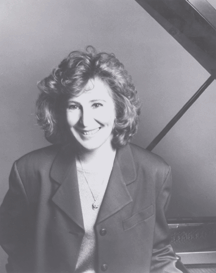

[ Metro | Metroactive Central | Archives ]
A Tasty Crumb
Solo Turn: Pianist Ursula Oppens outran the field--and the orchestra--in her performance of Mozart's Piano Concerto No. 18.
The San Jose Symphony scores with modernist George Crumb's haunting 'Landscape'
By Philip Collins
Three major works of distinctly different nature and high-caliber orchestral playing made the San Jose Symphony's program last Friday evening a signal musical event with something for everyone. Haunted Landscape by Pulitzer Prize-winning composer George Crumb radiated through the San Jose Center for Performing Arts with jeweled delicacy; its beguiling chemistry of unconventional sounds and even less familiar aesthetics coalesced into a compelling musical experience under the baton of Leonid Grin.
At the complete opposite end of the spectrum was Rachmaninoff's Symphony No. 2. Its grandiose scale and syrupy emotionalism contrasted with Haunted Landscape's transparent, understated manner as if from another planet. But the juxtaposition was marvelous. During a preconcert talk, Crumb mentioned that he is fond of contrasts, and Grin's programming of the Rachmaninoff accommodated the composer's penchant unconditionally.
In between these two sonorous pillars resided Mozart's Piano Concerto No. 18 in B-flat Major, featuring eminent pianist Ursula Oppens as soloist. For a number of reasons, this portion of the evening sagged. Oppens hit the piece at a run and never really settled into the score's pacing or got in sync with what the orchestra was up to.
Exhibiting a kind of precocious zest, the pianist keyed into Mozart's playfulness at the expense of accuracy and expressive breadth. She ran red lights repeatedly, speeding ahead of the fray, botched notes and all. Friday's display was not at all consistent with my previous encounters with Oppens' playing, which, in both contemporary and classical repertoire, fused together technical excellence and infectious spontaneity.
The orchestra lent stalwart backing, punctual and tuneful but short on the buoyancy and nuance that benefits Mozart's elegant texture plays. The ensemble work by the violins was handsomely joined, and the oboe/bassoon couplings were very snug.
The concerto sounded good, but its beauties were more moment to moment than continuous, because the music's lighter countenances were only touched upon. At its most vigorous--during the outer movements--the orchestra provided rousing wherewithal. The syncopated third movement (perhaps an anticipation of the third movement of Beethoven's Piano Concerto No. 4) was brisk and resiliently unified.
Rachmaninoff's Second enjoyed a realization that showed off the talents of this late-Romantic era composer in the best of lights. Grin's guidance of the work was absolute, embracing the symphony's entirety. The throughline of musical thought ran like a lighted fuse during the symphony's enormous four-movement plan. Grin championed the score's virtues so convincingly that its inconsistencies went by unnoticed. Each step of the way was forged with passion and determination, the like of which is too rarely experienced.
Principal clarinetist Michael Corner turned in yet another outstanding solo with his artful rendering of the adagio movement's central beauty, creating an expansive line in the instrument's utmost reaches. Of course the movement's popular theme--frequently deployed in television commercials for "101 of the Greatest Classical Melodies"--has sustained its stamina throughout countless recapitulations. Still, it was the clarinet's atmospheric reverie over ruminating strings that offered the movement's peak delight.
In a season that hosts few works of our time, Grin made a discriminating choice with Haunted Landscape. What appealing modernism Crumb creates. As pointed out by Grin beforehand, Crumb's treatment of the orchestra is painterly, and his visions are gorgeous to behold.
The usually foreboding prospects of amplified instruments (piano, two harps and hammered dulcimer), not to mention a massive percussion battery, proved tantalizing in Crumb's hands. Like brushwork in a Japanese landscape (or paintings by Miró and Klee), Crumb's orchestration is poignantly sparse, and silence plays as great a role as sound.
Crumb's far-reaching palette of timbral ideas offer delectable evidence of what an orchestra can do. The plucked strings and sound-board knockings on amplified piano and harps; the silvery breezes made by bowed cymbals, gongs and metal rattles known as crotals; the vaporous melodic gestures that emerge unexpectedly, then disintegrate beneath newly sounded layers--these and numerous other sonic delicacies combine to make Haunted Landscape a musical experience of timeless fascination. All this would not amount to much, however, if not for Crumb's profoundly musical intentions.
Among the myriad finds in Crumb's soundscape is a nested tribute to the late American experimentalist Edgard Varèse. A short melodic turn by the oboe in its highest tessitura (quoted from Varèse's Intégrales) works its way into the fabric through periodic repetitions before climaxing in a triple clarinet statement of shrill vibrancy.
Grin's direction of Haunted Landscape was detailed and articulate, vividly communicating the music's subtle tempo alternations while staunchly maintaining the score's atmospheric poise.
[ Metro | Metroactive Central | Archives ] This page was designed and created by the Boulevards team.

Christian Steiner
From the April 18-24, 1996 issue of Metro
Copyright © 1996 Metro Publishing and Virtual Valley, Inc.